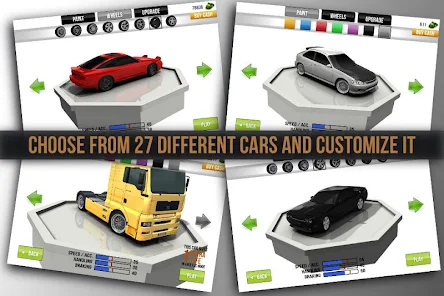Traffic racer in the vast landscape of mobile gaming, where titles vie for attention and downloads, few manage to stand out and capture the hearts of players worldwide. One such game that has not only gained immense popularity but also retained it over the years is “Traffic Racer.” Developed by Soner Kara, this adrenaline-pumping racing game has become a staple for mobile gamers seeking a quick and exhilarating escape. In this article, we will delve into the various aspects that make Traffic Racer a standout title, exploring its gameplay mechanics, graphics, sound design, and the factors that contribute to its enduring success.

Contents
Gameplay Mechanics of Traffic Racer
At its core, Traffic Racer is a straightforward and addictive endless racing game that puts players behind the wheel of a car as they navigate through traffic-filled highways. The premise is simple: drive as far as you can without crashing, all while earning points and in-game currency to unlock new cars and customize existing ones. The controls are intuitive, with on-screen touch buttons for acceleration, braking, and steering.
One of the game’s defining features is its realistic physics engine, which adds a layer of challenge and authenticity. Players must carefully manage their speed, avoid collisions, and weave through traffic to maintain momentum. The sense of speed is well-executed, creating a thrilling experience that keeps players on the edge of their seats.
To keep things interesting, Traffic Racer offers a variety of game modes, including Time Trial, Endless, Two-Way, and Free Ride. Each mode provides a unique twist to the gameplay, catering to different preferences and skill levels. The diverse range of environments, from cityscapes to deserts, adds visual variety and keeps the experience dynamic.
Graphics and Visual Appeal
Traffic Racer’s graphics might not boast the hyper-realistic visuals of some high-end racing games on other platforms, but what it lacks in graphical fidelity, it more than makes up for in charm and accessibility. The game adopts a simple yet effective visual style that prioritizes smooth performance and a wide range of supported devices.
The car models are well-designed, and the environments are crafted with attention to detail. The varying time-of-day settings, including day and night cycles, add a layer of realism to the experience. The lighting effects, such as reflections on wet roads, contribute to the overall immersive feel of the game. The use of vibrant colors and a clean aesthetic ensures that the game remains visually appealing even after multiple playthroughs.
It’s worth noting that the minimalistic approach to graphics serves a practical purpose, making Traffic Racer accessible to a broader audience. The game runs smoothly on a wide range of devices, including older smartphones, ensuring that more players can enjoy the adrenaline rush of high-speed highway driving.
Sound Design and Immersive Audio
A game’s audio is often an overlooked but crucial element in creating a fully immersive experience. Traffic Racer understands this well, delivering a soundtrack and sound effects that complement the fast-paced gameplay.
The in-game music consists of energetic tracks that match the intensity of the races. The beats sync with the speed of the player’s car, enhancing the feeling of speed and excitement. Additionally, the game allows players to use their own music library, providing a personalized touch to the audio experience.
The sound effects, from the roar of the engines to the screeching of tires during sharp turns, add a layer of realism to the game. Hearing the Doppler effect as other vehicles rush past creates a convincing sense of the bustling highway environment. The combination of well-chosen music and realistic sound effects contributes significantly to the overall enjoyment of Traffic Racer.
Customization and Progression System
One of the key elements that keep players coming back for more is Traffic Racer’s robust customization and progression system. As players accumulate points and in-game currency during races, they can use these resources to unlock new cars, upgrade existing ones, and personalize their driving experience.
The game features a diverse range of cars, from compact sedans to powerful sports cars, each with its own unique attributes. Players can choose vehicles based on their preferences, whether they prioritize speed, handling, or a balance of both. The sense of progression is further enhanced by the ability to upgrade cars with improvements to speed, handling, and braking.
Customization goes beyond mere performance upgrades. Players can choose from various paint colors and apply decals to give their cars a personal touch. While these visual modifications don’t impact the gameplay directly, they add a layer of personalization that fosters a connection between the player and their virtual ride.
Monetization Model and In-App Purchases
Traffic Racer adopts a freemium model, allowing players to download and play the game for free while offering optional in-app purchases. The in-app purchases primarily revolve around acquiring in-game currency (cash) or removing advertisements. The latter is a common practice in many free-to-play mobile games, providing players with the option to support the developers and enjoy an ad-free experience.
The in-app purchases are not overly intrusive, and the game remains entirely playable without spending real money. This balanced approach to monetization ensures that players who choose not to make in-app purchases can still fully enjoy the game without feeling pressured or disadvantaged.
Community Engagement and Updates
Soner Kara, the developer of Traffic Racer, has demonstrated a commitment to engaging with the game’s community and regularly updating the title to keep it relevant. Community feedback is actively sought, and bug fixes, optimizations, and new features are consistently implemented through updates.
The addition of new cars, environments, and gameplay modes through updates helps maintain the game’s freshness. This commitment to ongoing development has contributed to the game’s longevity, as players have a reason to return regularly to experience the latest content.
The Social Aspect: Leaderboards and Competitions
Traffic Racer incorporates a social element through its online leaderboards, allowing players to compete with friends and global players for high scores. The competitive aspect adds an extra layer of motivation, as players strive to climb the ranks and showcase their skills.
The leaderboard system is well-implemented, providing a sense of accomplishment to those who excel in different aspects of the game, such as distance covered, top speed, and the number of overtakes. This social integration fosters a sense of community and healthy competition among players, extending the game’s appeal beyond individual gameplay sessions.
Conclusion
In the realm of mobile gaming, where attention spans are often fleeting, Traffic Racer has managed to carve a niche for itself through its addictive gameplay, accessible graphics, immersive sound design, and well-balanced monetization model. Its enduring popularity can be attributed to the combination of realistic physics, diverse game modes, and a robust customization system.
As the mobile gaming landscape continues to evolve, Traffic Racer stands as a testament to the fact that a well-designed, engaging, and community-oriented game can capture the hearts of millions worldwide. Whether you’re a seasoned mobile gamer or a casual player looking for a quick thrill, Traffic Racer invites you to buckle up, hit the accelerator, and embark on an endless journey of high-speed excitement.
